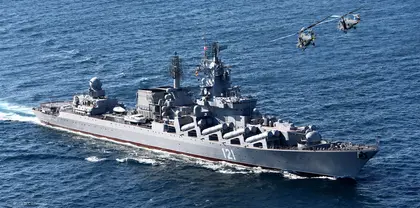On April 14, 2022, the flagship of Russia's Black Sea Fleet, the missile cruiser Moskva, sank in the same sea after being hit by two Ukrainian Neptune missiles.
Immobilized and dead in the water, the cruiser was still afloat but helpless, and a heavy storm prevented other Russian ships from coming to its rescue. A fire that broke out on board caused massive detonations of its missiles and other ammunition. Eventually, the cruiser began to list, then sank.
- Get the latest war in ukraine update from the Kyiv Post's daily news reports published today.
- Access the newest Ukraine news items published today.
JOIN US ON TELEGRAM
Follow our coverage of the war on the @Kyivpost_official.
Images taken by other ships show that, at times, the list exceeded 30%, and the failure of the Moskva’s commander, officers or crew to respond to radio calls suggest the control and communications system had been destroyed.
The Moskva had been one of the largest warships in Russia's Black Sea Fleet and one of the six largest in Russia's Navy. According to Forbes, the destruction of the Moskva (worth an estimated $750 million) has, so far, been Russia's single costliest loss in its war against Ukraine so far.
A warship of such a size was last destroyed in 1982, more than 40 years ago, during the Falklands war when the Argentinians seriously damaged the Royal Navy's destroyer HMS Sheffield, causing it to sink. The Moskva became the first flagship the Russian navy had lost since the Russo-Japanese war of 1905.

1,100 North Korean Casualties in Russia-Ukraine War: Seoul
In addition to losing the cruiser, Russia fleet suffered a heavy loss of personnel. Russian authorities reported 37 crewmen KIA and the rest, nearly 500, missing.
READ NEXT: Kyiv's New Normal – For Now
The destruction of the Moskva came as a surprise to the world and demonstrated the effectiveness of Ukrainian weapons. A product of the Ukrainian state enterprise, Luch it now has an international reputation as one of the most capable systems. It has also enhanced Luch’s reputation for expertise and high quality as Ukraine's leader in the design and development of airborne, anti-tank and anti-ship weapons.
The ground-based Neptune system is armed with guided anti-ship 380mm R-360 missiles, and consists of a total of 19 vehicles.
· The Neptune crew operates 6 launch systems, each armed with 4 missiles;
· The complex is controlled from the Launch Control Station;
· The launch containers are mounted on 6 loader vehicles;
· Four additional containers with R-360 missiles are transported by 6 transport vehicles.
The complex allows for the launching of up to 24 cruise missiles, each aimed at a different target, at an interval of 3-5 seconds.
The complex as a whole can carry 72 missiles, four in each launcher, loader, and transport vehicle.
The Neptune system is capable of destroying ships of any size and its configuration enables it to effectively engage both single and groups of ships. Additionally, it could be used against radar-visible ground targets.
The missile flies at an altitude of 3-10 meters, thus being practically invisible to ship’s radar, leaving the crew unaware of the imminent impact. While approaching its impact point, the missile activates its seeker head and accelerates.
The Neptune missile is designed to hit the ship broadsides, a few feet above the waterline, piercing the armor and allowing its 150kg explosive warhead to detonate inside the ship.
The Ukrainian Navy Commander, Rear Admiral Oleksiy Neyizhpapa said in a comment that he had not expected the Russian cruiser to sink:
"Personally, I thought it wouldn’t sink, because it was a such a large ship and our calculations were that it would take at least six cruise missiles to destroy a vessel of that class. Two missiles hit the target which, of course, wasn't enough, but there was a chance because the ship wasn't new, to put it mildly, and because we knew how manning on the Black Sea Fleet ships was organized."
The sinking of the Russian flagship illustrates the capability of the Neptune system to effectively engage surface targets at any time of day, in any weather and in any season, overcoming enemy fire and radio-electronic counteraction.
The maximum range of the R-360 missile is 300 km with a deployment time at a new launching position of 15 minutes. Because of its range it does not need to be fired from the shoreline and can standoff up to 25km.
Development and testing
The Luch design bureau has been developing hi-tech electronics and missiles for more than 30 years. The unique Neptune anti-ship system was developed in a very short time, with final live firing tests being successfully completed on June 17, 2020 in the Odesa region. Two R-360 cruise missiles were launched at a floating decoy and both hit the target.
According to the General Staff of the Armed Forces of Ukraine (AFU), the tests proved the missiles ability to overcome attempts at jamming and other specific radio interference in simulated combat conditions. The test missiles were accompanied and monitored by Sukhoi-27 jets of the Ukrainian Air Force.
Ukraine's combat experience proved that the Neptune meets the highest standards and can successfully compete with the world's best missile systems. Its very first use in combat paid off in spades. The Ukrainian Navy is very satisfied with the new weapon which enables them to take on heavy enemy warships at long ranges.
Neyizhpapa believes that the Neptune is a big step forward. "It really is a breakthrough in Ukrainian missile building," he said, stressing that the main task for Luch today is to produce these complexes as quickly as possible and for the AFU to make the most of them.
The manufacture of Neptune missiles is a multistage hi-tech process that takes at least nine months. According to Oleh Korostelyov, designer general and director general of the State Design Bureau Luch, the serial production of one battery set of missiles "takes between nine and 12 months."
Russia's reaction
As soon as information on the Neptune first appeared on the internet in 2015, the Russians rushed to discredit the new Ukrainian weapon. Their experts and media began to spread an allegation that the R-360 missile was an inferior copy of the Soviet-era Х-35 (SSC-6 Sennight), which Russia still uses in its Bal coastal defense missile system.
In fact, the Kremlin was simply unnerved to see Ukraine achieve in a few years what Russia had been unable to in decades. It took Soviet designers and engineers more than 20 years to devlop the Х-35 and the Russian military 10 years to integrate it into its coastal defense. Although the R-360 has some common features with the Х-35, it has much more in common with such anti-ship missiles as the US Harpoon, French Exocet, Japanese ASM-2, Swedish RBS-15, British Sea Eagle, or Turkish Atmaca.
The Ukrainian anti-ship complex Neptune has already played a significant role in defending the country against Russian aggression and demonstrated the ability of the AFU to destroy enemy ships at long ranges.
The weapon forced Russia to pull its Black Sea Fleet further away from the Ukrainian shores and give up on plans to carry out a landing operation on Ukrainian territory, including on Snake Island, which is within the Neptune's striking range.
You can also highlight the text and press Ctrl + Enter






